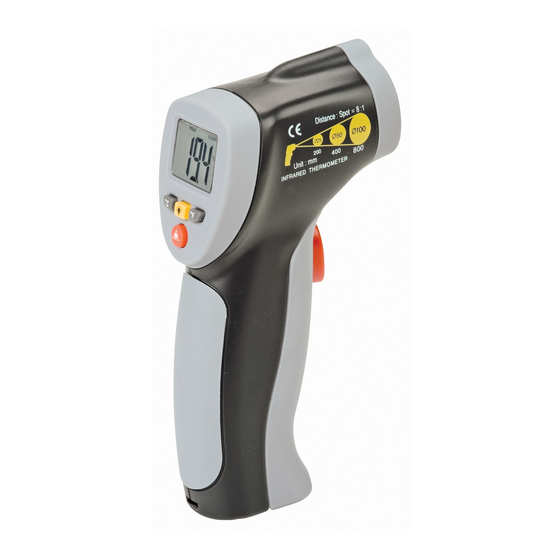
Advertisement
Advertisement
Table of Contents

Summary of Contents for REED ST-882
- Page 1 ST-882 Model Infrared Thermometer Instruction Manual reedinstruments...
-
Page 2: Wide Range Application
Features: • Precise non-contact measurements • Built-in laser pointer • °C/°F switchable button • Automatic Data Hold & Auto power off • Measures a 1 inch target from a distance of 8 inches • Backlit LCD display Wide range application: Food preparation, Safety and Fire inspectors, Plastic molding, Asphalt, Marine and screen printing, measures ink and dryer temperatures, Diesel and Fleet maintenance. Field of View: Meter’s field of view is 8:1, meaning that if the meter is 8 inches from the target, the diameter of the object under test must be at least 1 inch. Other distances are shown below in the field of view diagram. Refer to the chart printed on the meter for more information. -
Page 3: General Specifications
1. SAFETY • Use extreme caution when the laser beam is turned on. • Do not let the beam enter your eye, another person’s eye or the eye of an animal. • Be careful no to let the beam deflect off reflective surface which could strike your eye. • Do not allow the laser light beam impinge on any gas which can explode. 2. SPECIFICATIONS General specifications DISPLAY 3-1/2 digit (1999count) LCD with backlighting MEAS. RANGES -50°C to 550°C/-580°F to 1022°F RESPONSE TIME Less than 1 second OVER RANGE INDICATION... -
Page 4: Front Panel Description
Infrared thermometer specifications Range Resolution Accuracy -5°C to -20°C (-58°F to -4°F) ±5°C/±9°F; 0.1°C -20°C to 280°C (-4 °F to 536°F) ±2% of reading or ±2ºC /±4°F -201°C to 538°C (-330 °F to 1000°F) 1°C ±2% of reading or ±2ºC /±4°F Note: Accuracy is given at 18°C to 28°C (64°F to 82°F), less than 80%RH. Emissivity: 0.95 fixed value Field of View: Make sure that the target is larger than the unit’s spot size. The smaller the target, the closer you should be to it. When accuracy is critical, make sure the target is at least twice as large as the spot size. 3. FRONT PANEL DESCRIPTION 1 —... -
Page 5: Measurment Operation
4. INDICATOR 1 — Digital readout 2 — Temperature °C (Celsius) 3 — Temperature °F (Fahrenheit) 4 — Measuring indication 5 — Data Hold 6 — LOW battery indicator 7 — Laser Point 8 — Fixed emissivity (0.95) 5. MEASURMENT OPERATION 1 — Hold the meter by its Handle Grip and point it toward the surface to be measured. 2 — Squeeze and hold the Trigger to turn the meter on and begin testing. The display will light if the battery is still good. Replace the battery if the display does not light up. 3 — While measuring, the SCAN display icon will appear in the upper left hand corner of the LCD. 4 — While continuing to squeeze the Trigger: a. Push the Laser button to turn on the laser pointer. When the laser is on the laser icon will appear on the LCD over the temperature. -
Page 6: Battery Replacement
Note: Measurement considerations Holding the meter by its handle, point the IR Sensor toward the object whose temperature is to be measured. The meter automatically compen- sates for temperature deviations from ambient temperature. Keep in mind that it will take up to 30 minutes to adjust to wide ambient temperatures. Several minutes is required after a low temperature is measure before a high temperature measurement can be measured. This is a result of the cooling process which must take place for the IR sensor. - Page 7 7. NOTES: • How it Works Infrared thermometers measure the surface temperature of an object. The unit’s optics sense emitted, reflected, and transmitted energy, which is collected and focused onto a detector. The unit’s electronics translate the information into a temperature reading which is displayed on the unit. In units with a laser, the laser is used for aiming purposes only. • Field of View Make sure that the target is larger than the unit’s spot size. The smaller the target, the closer you should be to it. When accuracy is critical, make sure the target is at least twice as large as the spot size. • Distance & Spot Size As the distance (D) from the object increases, the spot size (S) of the area measured by the unit becomes larger. See: Figure 1 on Page 1. •...
-
Page 8: Emissivity Values
Emissivity Values Substance Thermal Substance Thermal Emissivity Emissivity Asphalt 0.90 to 0.98 Cloth (black) 0.98 Concrete 0.94 Human skin 0.98 Cement 0.96 Lather 0.75 to 0.80 Sand 0.90 Charcoal (powder) 0.96 Earth 0.92 to 0.96 Lacquer 0.80 to 0.95 Water 0.92 to 0.96 Lacquer (matt) 0.97 0.96 to 0.98 Rubber (black) 0.94 Snow 0.83 Plastic 0.85 to 0.95 Glass 0.90 to 0.95 Timber... - Page 9 Notes _________________________________________ ________________________________________________ ________________________________________________ ________________________________________________ ________________________________________________ ________________________________________________ ________________________________________________ ________________________________________________ ________________________________________________ ________________________________________________ ________________________________________________ ________________________________________________ ________________________________________________ ________________________________________________ ________________________________________________ ________________________________________________ ________________________________________________ ________________________________________________ reedinstruments...














Need help?
Do you have a question about the ST-882 and is the answer not in the manual?
Questions and answers